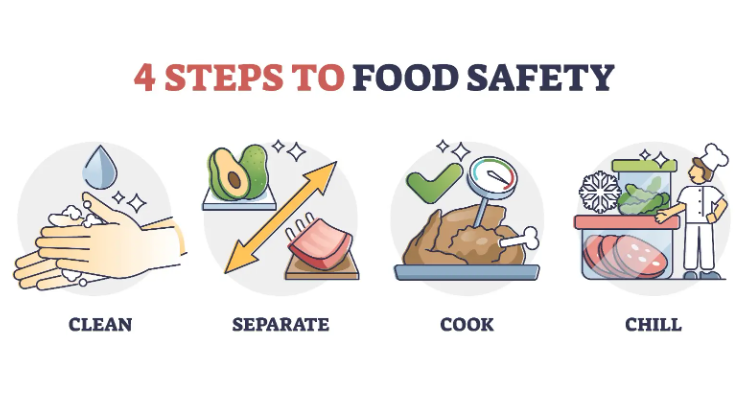The Hidden Crisis: Ensuring Food Safety in India Amid Growing Health Concerns
Social Issues Social Inequalities and exclusionPosted by NewAdmin on 2025-01-28 05:38:00 |
Share: Facebook | Twitter | Whatsapp | Linkedin Visits: 11

Food safety is emerging as a critical social issue in India, where millions rely on diverse food sources ranging from street vendors to high-end restaurants. Despite the country's rich culinary heritage, challenges related to contamination and inadequate hygiene practices often go unnoticed, posing serious health risks. With unsafe food contributing to malnutrition and foodborne illnesses, it is vital to address the systemic gaps that threaten public health.
India's population and diverse climatic conditions amplify food safety risks. Contamination at various stages—from farming and processing to storage and consumption—jeopardizes the quality of food. The World Health Organization (WHO) attributes nearly 50% of malnutrition cases in India to unsafe food and water, underscoring the magnitude of this issue. Children are particularly vulnerable, with foodborne diseases often impacting their growth and development.
While the Food Safety and Standards Authority of India (FSSAI) has established regulations under the Food Safety and Standards Act of 2006, enforcement remains uneven. Many small-scale vendors and unorganized food operators lack awareness or resources to comply with these standards, leaving consumers exposed to health risks. Similarly, improper agricultural practices, such as the overuse of pesticides and antibiotics, further compromise food quality.
Street food, a symbol of India's vibrant culture, illustrates the gap between tradition and modern food safety norms. While it is beloved for its flavor and accessibility, poor hygiene practices at stalls and a lack of infrastructure to maintain freshness raise concerns. Consumers are often unaware of the risks, making education and awareness campaigns essential.
Technology offers promising solutions. Blockchain can enhance traceability across the food supply chain, ensuring accountability from farm to fork. Internet of Things (IoT) devices monitor storage and transportation conditions in real-time, while Artificial Intelligence (AI) can predict contamination risks and streamline interventions. However, these technologies must be integrated with grassroots-level training and infrastructure improvements to make a significant impact.
The issue of food safety extends beyond individual choices; it is a collective responsibility. Strengthening government regulations, supporting local farmers in adopting good agricultural practices, and encouraging responsible food businesses are crucial steps. Simultaneously, consumers must remain vigilant, prioritize hygiene, and advocate for stricter standards.
As India grapples with this hidden crisis, addressing food safety is not just about preventing illness—it is about securing the well-being and dignity of its people. It’s time to amplify the conversation and demand systemic changes that ensure every meal served in the country is both delicious and safe.
Search
Categories
- Sports
- Business
- History
- Politics
- International
- Science & Technology
- Social Issues
- Disaster Management
- Current Affairs
- Education
- Startup Business
- Startup News
- Awards
- Community Services
- Fundraising Events
- Volunteer Services
- Health Initiatives
- Innovations and Initiatives
- In News
- dummybanners
- Awards
- Partners
- Products
- Press Releases
- News
- Fast Check
- South
- సినిమా
- Gallery
- Sunday Chronicle
- Hyderabad Chronicle
- లైఫ్ స్టైల్
- National
- క్రైం
- ట్రెండింగ్
- జాబ్స్
- అంతర్జాతీయo
- బిజినెస్
- రాజకీయం
- బిజినెస్
- సంపాదకీయం
- నవ్య
- చిత్ర జ్యోతి
- క్రీడలు
- జాతీయం
- తెలంగాణ
- తాజా వార్తలు
- మన పార్టీ
- మన నాయకత్వం
- మన విజయాలు
- డౌన్లోడ్స్
- మీడియా వనరులు
- కార్యకర్తలు
- North East Skill Center News
- Government Schemes
- Entrepreneurship Support
- Employment Opportunities
- Skill Training Programs
- Departments
- Investments
- Initiatives
- Resources
- Telangana IT Parks
- Events & Jobs
- Press Releases
- News
- Airport News
- Newtons Laws of Motion
- Karbonn in Business
- Investments in Karbonn
- Company quarterly sales
- Markets
- Auto News
- Industry
- Money
- Advertisements
- Stock target
- Company Updates
- Stock Market
- Company Sales
- Staffing and HR
- Constituency Assembly
- General News
- Srikalahasti Temple
- Bojjala Sudhir Reddy
- Technology & Innovation
- Sports
- Business
- Products
- Industries
- Services & Trainings
- Tools & Resources
- Technology Integration
- Drug Seizures & Arrests
- Telangana Narcotics
- Law & Enforcement
- Rehabilitation
- Nationwide Drug Policing
- Nigeria Seizures
- Global Operations
- Drug Awareness
- Drug Enforcement Tech
- NCB Drug Seizures
- Judicial Crackdown
- India's Surveillance Tools
- Cross-Border Links
- Women Safety
- Cyber Crimes
- Drug Abuse
- Traffic & Road Safety
- Community Connect
- Public Safety Alerts
- Citizen Assistance
- Nellore City News
- Politics & Administration
- Events & Festivals
- Agriculture & Rural
- Business & Economy
- Health & Wellness
Recent News
- Putin Playbook: The Art of Declaring Stability
- Capital Gains Subject to Same Tax Rates Even with Section 87A Rebate
- Star Indian Fast Bowler Ruled Out Of Duleep Trophy Due To A Shoulder Injury
- The Ongoing Battle Against Seles Disease
- TPCC chief announces plan for party committee formation, initiates 'vote chori' campaign
- Devendra Fadnavis on Mental Health, Patriotism, and Responsible Freedom
- CM Fadnavis Advocates For 'Balance' In Deciding Stray Dog, Kabootarkhana Issues
- BMC Polls Likely In October, November Or December, EC Will Take Final Call: CM Fadnavis